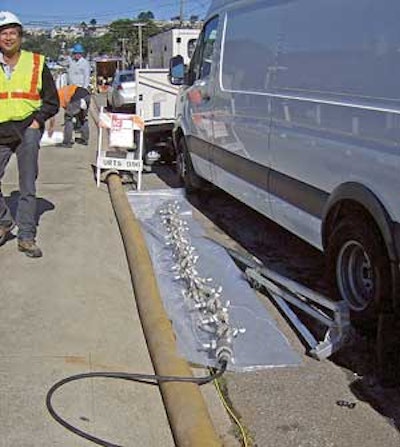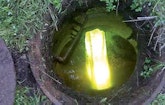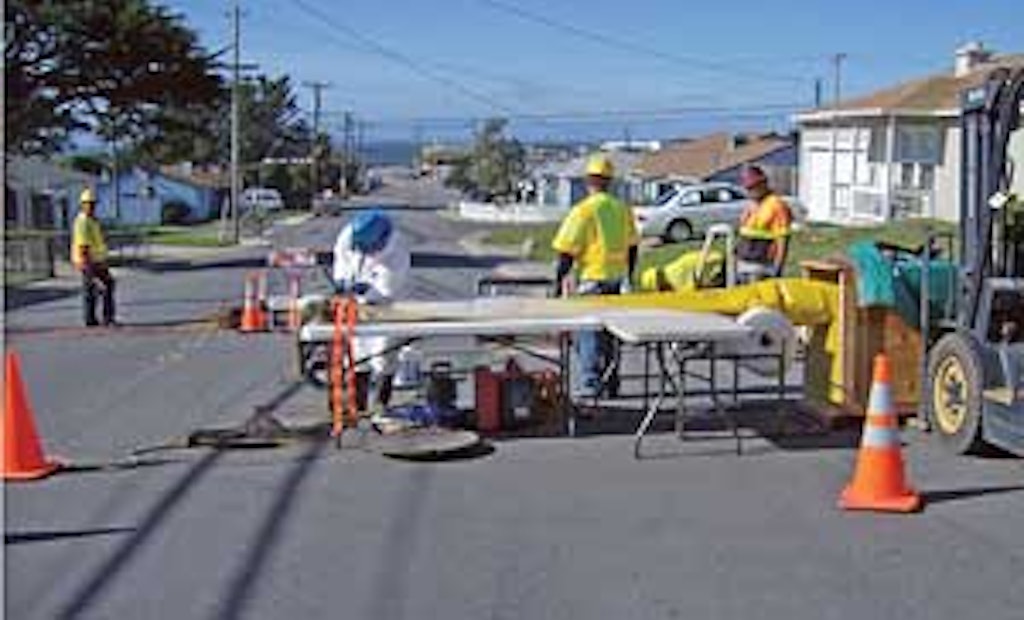Interested in Rehab/Relining?
Get Rehab/Relining articles, news and videos right in your inbox! Sign up now.
Rehab/Relining + Get AlertsWorkers cleaning the Palmetto Avenue trunk line in Pacifica, Calif., began bringing back large pieces of the asbestos concrete pipe with their Warthog spinner nozzle (StoneAge Tools).
They immediately shut down the operation and called for the inspection crew. A SuperVision 140 system from Envirosight revealed that hydrogen sulfide gas had corroded 0.75 to 1 inch of the 1.5-inch-thick crown. Furthermore, cleaning the pipe was causing the layers to delaminate.
Brian Martinez, manager of the Pacifica Sanitary Sewer Collection System Division, and Maria Aguilar, P.E., associate engineer, researched solutions. Martinez had read European studies on fiberglass-reinforced UV-cured liners. Looking for U.S. manufacturers, he found LightStream LP in San Diego and a list of certified installers.
“With more than half the crown of the sewer missing, we needed a liner with structural strength,” says Martinez. “ASTM D790 tests showed that the StreamLinerUV had a flexural modulus of more than 1.8 million psi and a flexural strength of more than 60,000 psi. Furthermore, the UV-cure process significantly reduces bypass time, which lessens the chance of SSOs.”
Another major factor was the Calera Creek Water Recycling Plant, which uses autothermal aerobic digesters. Martinez was concerned that contaminants from styrene-based polyester resins would kill the extremely sensitive nitrifying organisms.
Lining 8,996 feet of the 9,100-foot sewer was one of the city’s largest infrastructure upgrades since the early 1980s. Despite unexpected obstacles, working at night and on steep hills, and never having installed UV-cured liners before, Dexal Construction Inc. in Santa Rosa, Calif., completed the work safely and successfully.
Big and mean
The trunk line moves much of the city’s waste. Its failure would cause major property and environ-mental damage. The sewer begins as 2,400 feet of 12-inch pipe with multiple 6-inch mains. As it runs downhill to a pump station, it increases to 1,650 feet of 15-inch pipe. The last transition is 5,050 feet of 18-inch pipe. The pipes change diameters at manholes.
The project began with the 18-inch segment along Palmetto Avenue. The sewer’s height made it necessary to work at night. “We didn’t start traffic control until 7 p.m.,” says Pasqual (Paz) Hernandez, general manager for Dexal Construction. “We began bypassing sewage between 8 and 9 p.m., and had to finish before 8 a.m. when heavy flows resumed.”
Once crews bypassed a segment, city workers cleaned it using a Vac-Con combination sewer cleaner (3,000 psi/55 gpm), fitted with a C-Ray bottom-cleaner nozzle (NozzTeq) with downward-facing jets to avoid delaminating more pipe. Upstream of most 90-degree turns, they encountered 3-inch-thick deposits of impacted sediment extending one or two feet.
“In places, the material accounted for one-quarter of the pipe’s diameter, and it had the consistency of asphalt,” says Hernandez. “It was extremely cantankerous and didn’t want to come out.”
City crews used a chain flail nozzle (ENZ USA) to fracture the sediment, then flushed out the pieces with the C-Ray nozzle. Some deposits took all night to remove, extending the project from the expected one-month duration to one-and-a-half months.
Before installing a liner, the inspection team guaranteed that the pipe was spotless with no protruding taps that would interfere with the pull. The longest run was 641 feet of 18-inch liner.
Down the hole
Although Hernandez and his crew were experienced with cured-in-place pipe felt liners, this was their first job after certifying as StreamLinerUV installers. Consequently, LightStream sent consultants Rory Simon and Ron Evergreen to oversee the project.
The wetted-out liners, weighing 9 to 12 pounds per foot, arrived from the San Diego factory wrapped in UV-protective yellow foil and folded in crates. The 18-inch liners were 6-mm thick, and the 12- and 15-inch liners were 5-mm thick. The shrinkage factor was zero to 0.2 percent.
To install the liners, two workers laid a roller assembly over a manhole, set up two tables behind it, and used a forklift to position a crate behind the second table. A drum in back of that table held 200-mm white sliding foil, which protected the liner and facilitated its passage as it was dragged along the pipe.
The sliding foil went under the liner as it was delivered onto the table, where the crew folded it in half so the width fit over the roller and went down the manhole. They then folded the nose back over a nylon choker with a cable attachment and secured the nose with two nylon straps. Hernandez used a 505 Condux winch rated at 5.5 tons to pull the liners from downstream to upstream manholes. Installation moved slowly, an average of 10 feet per minute, to protect the liner.
Air and light
When the liner reached the other manhole, the crew freed it, but left enough material to slip over round cylindrical cans called gate valves, one in each end of the liner. They were duct-taped, then winched down with a ratchet strap for an airtight seal.
“I inflated the liner to 8 psi from the command station in the liner truck parked at the downstream manhole,” says Hernandez. “The crew then removed the upstream can to insert the 13-foot-long Light Train and reattached the can. Then I pressurized the liner again.”
As the men pulled a rope attached to the light source, a camera on each end of it enabled Hernandez to inspect the liner for imperfections and fit. “If something were wrong, I could collapse the liner and fix the problem,” he says. The cameras found no imperfections.
Communicating by two-way radio, Hernandez told workers when to stop pulling as the light source reached the end of the liner. After setting certain fields in the operating program, he ignited the eight UV lights and the computer controlled the speed of the cable reel, which pulled the lights upstream as they cured the resin.
Gravity rules
A hillside easement with 20 percent slope at the uppermost segment was the most challenging of the 12-inch installations. “We saved that run for last to give us time to plan the secondary bypass requirements,” says Hernandez. “The topmost and middle manholes each had two 6-inch mains, and two laterals tied in along the easement. The setup required seven pumps.” To avoid adding more pumps, Hernandez used a single 250-foot-long liner and pulled it through the middle manhole.
His crew worked nonstop to complete the setup and bypass and position the liner. The most crucial aspect was winching it into the downstream manhole, then holding the liner against the pull of gravity. “If we hadn’t set chocks in the manhole, the liner would have been skating down the pipe,” says Hernandez. It took 24 hours to complete the job, including reinstatements.
Final inspections of the pipe showed that the liner had formed a slick, smooth surface. The trunk line was rehabilitated with no sewer overflows or safety incidents.








